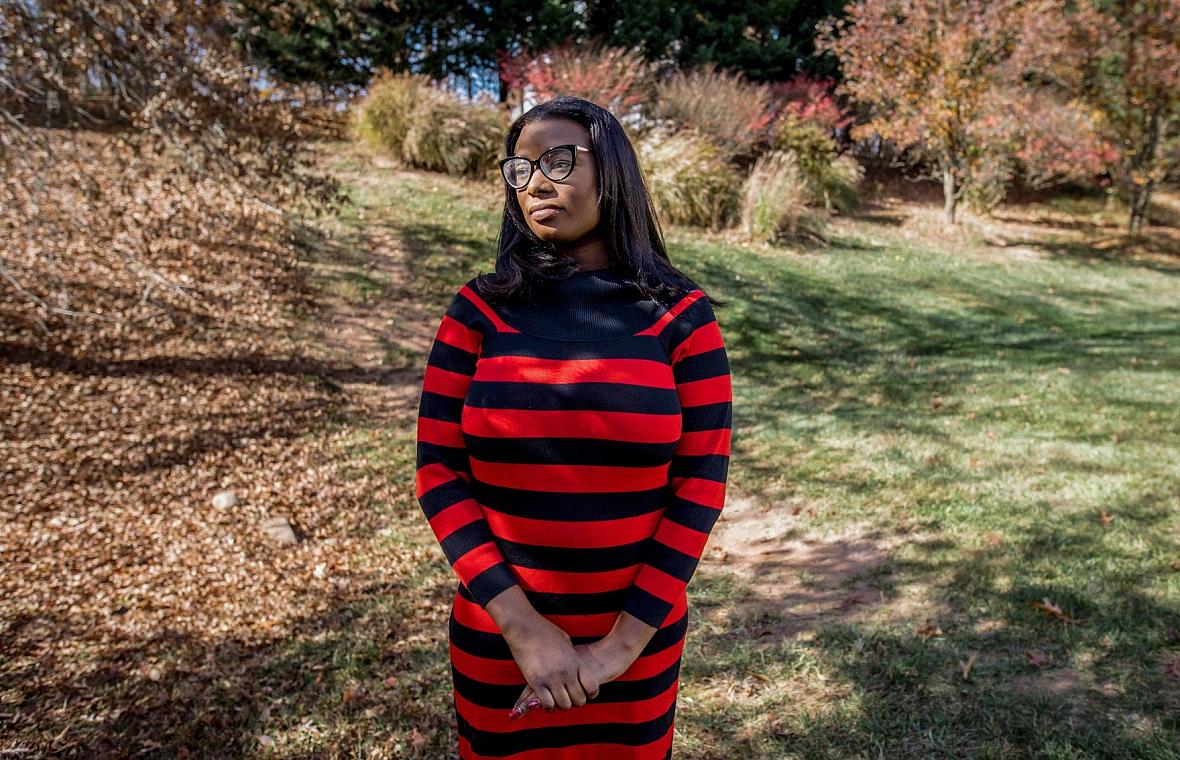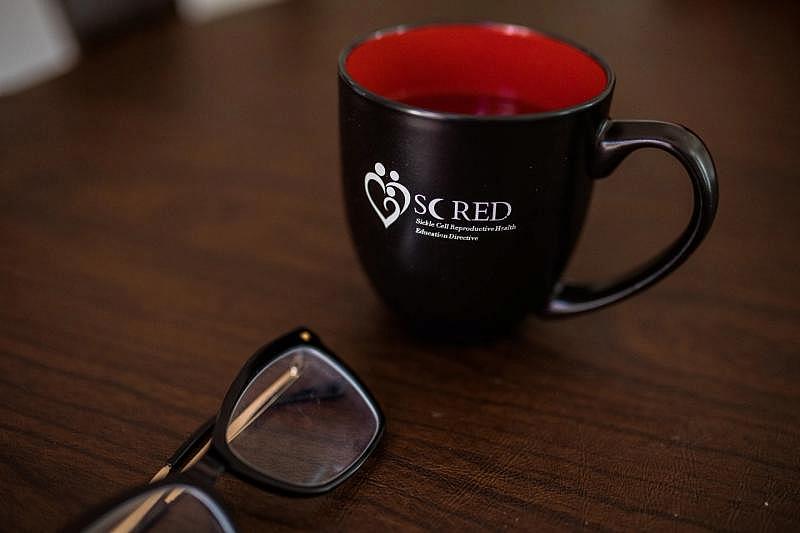Teonna Woolford has always said that when it came time to build a family, her ideal would be to have six kids.
Why six?
"I don't know where that number came from. I just felt like four wasn't enough," says Woolford, a Baltimore resident. "Six is a good number."
Woolford, 31, was born with sickle cell disease. The genetic disorder affects patients' blood cells. They become misshapen, which makes it harder for the blood to carry oxygen and flow throughout the body. This can cause strokes, organ damage and frequent bouts of excruciating pain.
Sickle cell disease affects an estimated 100,000 people in the U.S. and the vast majority of them are Black. Federal and charitable dollars dedicated to sickle cell pale in comparison to other less common diseases that affect a majority white patients.
Physicians and researchers say the disease is a stark example of the health inequities which pervade the U.S. health system. A poignant expression of this, patient advocates say, is the silence around the impact on fertility, and lack of reproductive and sexual health care for the young people living with this complex disease.
Crushing hopes for fertility
Woolford has lived through the entire gamut of sickle cell complications. By 15, her hip joints had become so damaged that she had to have both hips replaced. She was dependent on frequent blood transfusions to reduce pain episodes and vascular damage, and her liver was failing.
"So many complications, infections, hospitalizations, and so by the time I graduated high school, I just felt defeated [and] depressed," says Woolford, who first spoke with an NPR reporter from a hospital bed in Baltimore, Maryland. She'd experienced a sickle cell pain crisis a few days earlier, and was still receiving pain medication and intravenous fluids.
In her late teens Woolford sought out a bone marrow transplant: a treatment that enables sickled cells in the patient's body to be replaced with healthy cells from a stem cell donor. The procedure comes with risks, and not everyone is eligible. It also relies on finding a compatible donor match. But if it works, it can free a person from sickle cell disease forever.
Woolford couldn't find a perfect match, so she enrolled in a clinical trial where doctors could use even a half-matched donor.
As part of the bone marrow transplant, patients are first exposed to chemotherapy, which can impair or eliminate fertility.
Woolford hesitated. After all, her ideal family included six children.
Woolford has sickle cell disease and has been unable to afford fertility preservation for years. She started a non-profit to provide financial grants for patients who need fertility care, and advocates for more awareness about the effects of sickle cell on patients' family planning and sexual health. / Rosem Morton For NPR
When she told her doctor about her worry, his response crushed her. "This doctor, he looked at me and he was like, 'Well, I'll be honest, with all the complications you've already had from sickle cell, I don't know why you're even worried about this process making you infertile because you're probably already infertile.'"
Even without a transplant, sickle cell disease can damage patients' bodies in ways that can affect their ability to have children, according to Dr. Leena Nahata, a pediatric endocrinologist at Nationwide Children's Hospital in Ohio.
For women, chronic inflammation and sickling of blood cells in the ovaries can make it harder to get pregnant. For men, sickled blood can jam inside the blood vessels of the penis, and that can cause painful, unwanted erections which last for hours. This condition, called priapism, can damage sexual function and decrease sperm count.
And it's not just the disease. Researchers are evaluating how some widely-used treatments may affect fertility — for example by decreasing sperm count.
"It remains unclear how that translates directly to fertility outcomes, but at least raises the concern that this may be an issue," Nahata says.
Even more concerning to Nahata were the results of a small study she co-authored that showed some patients are unaware of the many fertility risks related to sickle cell disease.
Would hope for a cure mean giving up on fertility?
Woolford was only 19 when her doctor shocked her by telling her she was probably already infertile. But no one could be sure, so she held out hope that she might still undergo a procedure to preserve her fertility, before undergoing the chemotherapy required for the bone marrow transplant.
After extensive research, she learned egg freezing could cost more than $10,000, her insurance wouldn't cover it, and she couldn't afford that on her own.
Woolford wondered if maybe she could find another way to pay for egg freezing. "So I started looking into financial resources. And I saw all these foundations [that] give away grants. But you had to have a diagnosis of cancer," she says.
"So long story short, I went through with a [bone marrow] transplant, kind of feeling like if I was going to be cured from sickle cell, it'd be a fair tradeoff to give up my dream of biological children."
Unfortunately, the partial-match transplant did not work. Woolford's body rejected it.
"So, here I am. I am 30, still have sickle cell disease and I'm infertile," she says.
A grim thought still sometimes pops up in Woolford's mind: Maybe if she had cancer instead of sickle cell, her dreams of having biological children could still have come true.
How systemic racism affects access to care
The first description of sickle cell disease in medical literature was published over a century ago. Because the vast majority of sickle cell patients in the U.S. were Black, it quickly became labeled as a "Black disease," and with that came a legacy of systemic racism that still affects patients today.
Black patients tend to have less social capital and fewer resources, according to Dr. Lydia Pecker, a sickle cell disease researcher and assistant professor of medicine at Johns Hopkins University. Pecker has studied fertility in sickle cell disease, and says there's a stark contrast between resources available to cancer patients versus sickle cell patients, when it comes to fertility treatment.
"There are any number of foundations, large and small, that help support and pay for fertility preservation for people with cancer," Pecker says. "Those foundations actually work with fertility preservation centers to negotiate lower rates for affected people."
There are clear clinical guidelines stating children with cancer going through chemotherapy should be referred for fertility preservation.
Children with sickle cell disease going through transplants are exposed to chemotherapy too, "but we don't really have guidelines like that yet for people with sickle cell disease," Pecker says.
It's not a perfect comparison, she adds, because the kinds of chemotherapy drugs used in pediatric cancer are different from the chemotherapies used in sickle cell treatment. But fertility preservation can be crucial when there is any risk of treatment-associated fertility impairment. Without clear and widely adopted clinical guidelines, sickle cell patients may not get referred to appropriate care.
Pecker says current medical practice forces sickle-cell patients to make a difficult choice: "Like, you can have treatment or you can have fertility. But what we say in cancer care is you can have treatment and you can have fertility."
Expensive treatment and fighting for access
"Historically, we in the sickle cell community have really had to focus on survival over quality of life. Now, thanks to advances in science and the resilience of the community, we are living longer. Now, it is not enough to survive. For a lot of us, having an optimal quality of life involves having children." / Rosem Morton For NPR
In the U.S., health insurance coverage for fertility preservation and treatment is not guaranteed and varies from state to state. Only eleven states have laws that mandate coverage for fertility preservation for patients who undergo treatments that could imperil their ability to have biological children – usually referred to as iatrogenic treatments – like chemotherapy or radiation.
But even those laws don't always help, says Dr. Irene Su, an OB-GYN at the University of California San Francisco, who researches fertility preservation policies.
Su says these laws are usually very vague in terms of who qualifies: "If you give insurers room to interpret, it's possible that they can be very broad, or they can be very narrow."
This means that many sickle cell disease patients who don't have this coverage are forced to pay out of pocket.
Phillip Sanders of Arkansas was a sophomore in college when his sickle cell disease complications ramped up.
"By 2016, that whole year, I spent 60 percent of my life in the hospital," he says.
Not long after, he married his college sweetheart. They wanted to have children, but were unable to get pregnant. A doctor then told them their best bet was to undergo intrauterine insemination, a fertility treatment where the highest-quality sperm is selected and inserted directly into the uterus.
Sanders' wife got pregnant after four attempts, but none were covered by insurance.
"It's so expensive. You're talking about thousands of dollars each try," Sanders says. "I mean, we had to, of course, borrow money. Because, you know, at the same time, I was going through school, opening a business, and I was in the hospital, always. So it was extremely tough."
Like Woolford, Sanders enrolled in a clinical trial for a bone marrow transplant, and it was a success.
He is now 31, is sickle cell disease free and has a son, Phillip, Jr.
Teonna Woolford for her part, has had to focus on other goals. After her transplant failed, the ongoing toll of the disease on her body continued. She has had to come to terms with the impossibility of her ever having a biological child of her own.
Woolford launched a new nonprofit, The Sickle Cell Reproductive Health Education Directive, to raise awareness of fertility issues at medical conferences and among patients. A future goal for the organization is to provide financial grants to sickle cell patients struggling to pay for fertility preservation and treatments.
Most days, Woolford finds the work empowering. On other days, she admits it reminds her of the bleak personal reality that she will probably never conceive a child.
"It's really hard, because I don't think a lot of people realize that I'm fighting for something that I didn't have access to," she says.
At this point, she said, it's no longer a medical justice fight. It's a reproductive justice one.
Reporting for this story was supported by the USC Annenberg Center for Health Journalism's Impact Fund for Reporting on Health Equity and Health Systems. It was produced in partnership with Side Effects Public Media, WFYI and KHN (Kaiser Health News).
Copyright 2022 WFYI Public Media
Did you like this story? Your support means a lot! Your tax-deductible donation will advance our mission of supporting journalism as a catalyst for change.
[This article was originally published by WFYI and KERA News.]




